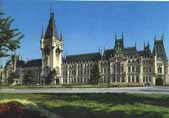The
invention of the telephone marks an outstanding stage in the history
of telecommunications, as this is the first device able to transmit
sound in all its complexity: height, intensity and tamber.
In 1860, a German
professor Philippe Reisse achieved a device which could transmit music
sounds with the help of electricity. He managed to commercialize his
telephone, but the quality of the device was not allowing the transmission
of speech.
The telephone was invented by the American Graham Bell who in 1876
prepared the first such device of practical utility. The paternity
of the telephone was decided consequent to a trial due to the fact
that 2 hours later than Bell, Elisha Gray also submitted a license
request based on a similar structure.
In 1877, Bell
Telephone Company Edison was created and thus telephony entered the
market. The same year, Western Union Company asked Thomas Edison to
finalize a set so to compete with Bell Company. Edison created an
emitter of variable resistance more sensitive than Bells’, which
was to become the first graphite microphone (27 April 1877). One year
later, David Hughes made a very sensitive microphone out of charcoal
pencil.
The first telephone
sets were uncomfortable because the microphone and the receiver headphones
were not fixed. Then, the microphone was fixed to the main body of
the set, while the headphones were mobile. In 1882, a support was
created for fixing the receiver headphones and the microphone. As
for the power supply, telephonic posts used local and central batteries,
according to the location of the power supply source of the microphone
circuit.
Due to the increasing
number of users, telephones were connected to telephonic centrals.
The first such device was inaugurated in Boston in 1877. At the beginning,
centrals were manual, that they were used by operators. Like in the
case of the telephones, the functioning of centrals depended on a
local or central battery. The possibility of constructing automatic
centrals was approached already in the last decades of the 19th century.
The first central of Europe, installed in Amsterdam in 1898, was designed
for 400 users.
Telephony was
at the beginning using telegraphic lines, but in time these proved
to be insufficient. The multiplex system was adopted both in telephony
and telegraphy as it enabled the simultaneous transmission on the
same circuit of several phone calls. An important contribution in
the field of multiple telephony was the one of Romanian engineer Augustin
Maior (1882-1963) who in 1905 experimented multiple telephonic communications
with the help of alternative currents of high frequency. Multiple
and simultaneous telephony was made possible by the use of multi-wired
and coaxial cables, which solved the problem of trans-oceanic connections.
At the end of
1877, experiments with telephonic sets were carried out at the “Tierich&Leopolder”
Factory of Telegraphic and Signaling Devices in Bucharest. In Moldavia,
Titu Maiorescu, who was in Dorohoi, spoke on the phone with the Mihaileni
station. In Iasi, in 1882, some Morse devices of the police stations
were replaced with telephone sets. It was a communication system using
the telegraphic line. The telephonic line was extended in 1887, public
telephony was introduced in 1896 and automatic telephony in 1936.
In 1883, the
first manual central with five numbers was also installed. The first
interurban communications were carried out on the Bucharest-Sinaia
and Bucharest– Braila – Galati routes. În 1906,
the first automatic central with 20 numbers was installed. Yet, automatic
central became really important in 1927, when such a device with 300
numbers started functioning.

